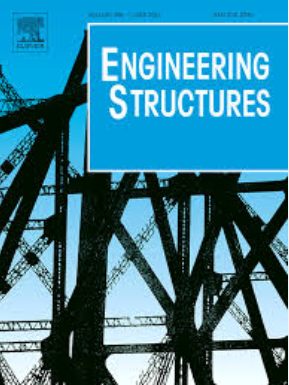Instability of compressed members in timber trusses assembled with punched metal plates
IF 5.6
1区 工程技术
Q1 ENGINEERING, CIVIL
引用次数: 0
Abstract
This study addresses the instability of wooden trusses assembled with punched metal plates. The instability of compressed wooden elements is a complex problem due to the specific boundary conditions, the timber orthotropy, and the difficult quantification of the defects. This research presents an analytical framework based on the Eurocode approach for predicting the instability of compressed wooden elements, considering the effect of boundary constraints representative of punched metal plates. The general aspects of this research are twofold: (i) proposing an analytical approximate expression for assessing the theoretical buckling load of compressed beams with elastic boundary constraints; (ii) deriving the buckling design curves as a function of the geometric imperfection of the structural element. The authors refer to the constraints exerted by punched metal plates, experimentally characterized to determine the response along the six degrees of freedom. The experimental results were used to generate a high-fidelity finite element (FE) model of the connection, validate it using digital image correlation, and estimate by extrapolation the stiffness properties of a selection of punched metal plates. Additionally, a secondary FE model was developed to simulate the out-of-plane deflection of structural elements with different types of punched metal plates, predict the failure load from static incremental analysis, and estimate the buckling design curves. In conclusion, the research aims to specialize the design method of compressed members according to the Eurocode, taking explicitly into account the boundary constraints representative of punched metal plates. It is found that while the theoretical instability load of beams with elastic constraints closely approximates that of the clamped condition, the instability load under imperfections resembles the pinned condition more closely. This observation leads to systematically higher imperfection coefficients for elastic constraints than pinned conditions.
求助全文
约1分钟内获得全文
求助全文
来源期刊

Engineering Structures
工程技术-工程:土木
CiteScore
10.20
自引率
14.50%
发文量
1385
审稿时长
67 days
期刊介绍:
Engineering Structures provides a forum for a broad blend of scientific and technical papers to reflect the evolving needs of the structural engineering and structural mechanics communities. Particularly welcome are contributions dealing with applications of structural engineering and mechanics principles in all areas of technology. The journal aspires to a broad and integrated coverage of the effects of dynamic loadings and of the modelling techniques whereby the structural response to these loadings may be computed.
The scope of Engineering Structures encompasses, but is not restricted to, the following areas: infrastructure engineering; earthquake engineering; structure-fluid-soil interaction; wind engineering; fire engineering; blast engineering; structural reliability/stability; life assessment/integrity; structural health monitoring; multi-hazard engineering; structural dynamics; optimization; expert systems; experimental modelling; performance-based design; multiscale analysis; value engineering.
Topics of interest include: tall buildings; innovative structures; environmentally responsive structures; bridges; stadiums; commercial and public buildings; transmission towers; television and telecommunication masts; foldable structures; cooling towers; plates and shells; suspension structures; protective structures; smart structures; nuclear reactors; dams; pressure vessels; pipelines; tunnels.
Engineering Structures also publishes review articles, short communications and discussions, book reviews, and a diary on international events related to any aspect of structural engineering.
 求助内容:
求助内容: 应助结果提醒方式:
应助结果提醒方式:


